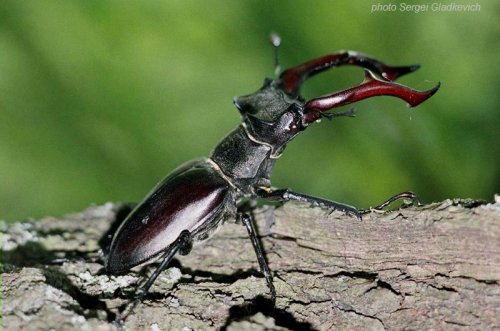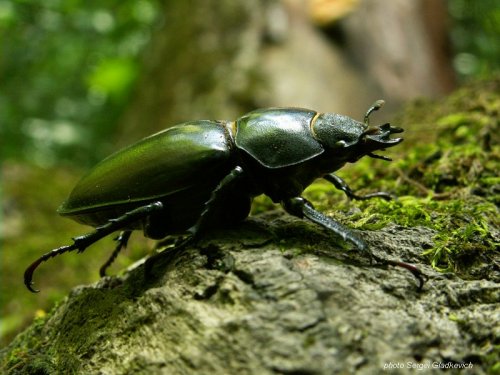There is no more known beetle in Ukraine than stag beetle (Lucanus cervus Linnaeus, 1758). It is biggest representative of Coleoptera order. It is impossible to mix it up with other insect. In spite of its small numbers, stag beetle could be found in different regions of Ukraine. At the same time, it is a species, whose natural habitat decreases and in the nearest future could become endangered. Study of biology and spreading of this species is an important and top-priority objective for development of actions for its protection.
A total natural habitat of stag beetle is rather wide. It covers Central, Southern and Eastern Europe and Northern Africa. Years ago it was usual species for the whole Europe, but nowadays its number decreases everywhere. Spreading of stag beetle is connected not only with regions and climatic zones, but with specific biotopes that are its typical locations. Usually beetles could be found in broad-leaved and mixed forests with oaks. In Ukraine, such forests are in Crimean foothills and in the Carpathians. Sometimes it could be found also in oak woods of Northern, Central and Eastern Ukraine.
Stag beetle lives mostly in oak old-growth forests. Its larvae live in oak stocks up to seven years and feeds there.

Male and female beetles differ from each other by size of mandibles, so it is easy to differentiate them. The total size of male body is up to 7.5 centimetres, female body – up to 5 centimetres. Male beetle has big mandibles that could reach quarter of total body length. Stag beetle uses them for fighting. There is widely known belief that beetles kill each other, but in fact each of them just tries to enfold his opponent in mandibles and throw over the back. Beaten beetle turns over in normal state and goes away. Sometimes stag beetles use their jaws for defence against assailants including people. Female beetles are smaller than male and have considerable smaller mandibles, but could defence itself.
Stag beetle flies well. It often could be seen on the high from 1 to 10 meters. Adult beetles could be found from May till July. They feed juice of damaged trees, mostly oaks, sometimes beeches or birches.
Male beetles mainly die soon after coupling. Sometimes in places of coupling it is possible to find gathering of alive and dead beetles. In time, females also die after oviposition in tree hollows and stumps. Evolvement of grubs lasts mostly near 5–6 years. The grub is blind, cream coloured, almost transparent with orange head and ambulatory legs. Using their ambulatory legs, grubs can chirr to communicate each other. During its life grub has some sloughs and in May of last year of evolvement it becomes a pupa. There is no data on reproduction of stag beetles in captivity. Most likely, artificial breeding had never carried out.
Number of stag beetle is low almost everywhere and continue to decrease. Reasons of extinction of this insect species are elimination of old-growth oak forests that are the main natural habitats of stag beetle for purpose of forestry and using pesticides for forests. Unfortunately, old big trees with hollows are priorities for cutting. Irresponsible people also affect decreasing of number of stag beetles through collection of beetles or just for fun. Now stag beetle is protected under the Red Book of Ukraine (2nd category). Extermination of beetles or their habitats is restricted. It is entered to many Red Lists of different protected areas of Ukraine. Conservation and monitoring of this insect carries out in other European countries.

Only conservation of natural biotopes, including creation of entomological natural reserves on the territories of oak woods and conservation of single old oaks could be an action for protection of this species. Besides, environmental education of youth should play an important role in conservation of stag beetle.
